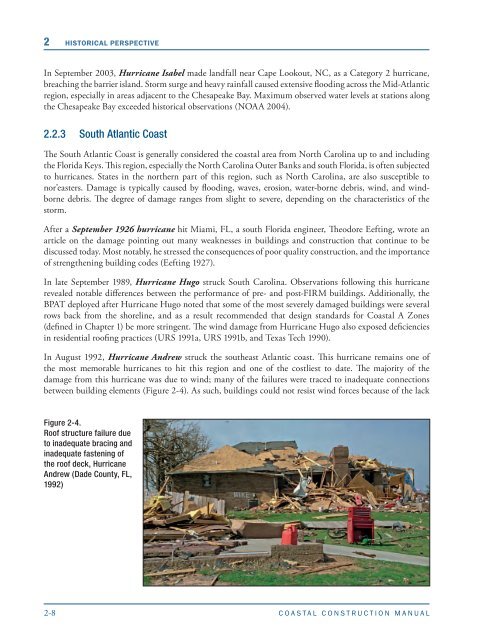Coastal Construction Manual - National Ready Mixed Concrete ...
Coastal Construction Manual - National Ready Mixed Concrete ...
Coastal Construction Manual - National Ready Mixed Concrete ...
Create successful ePaper yourself
Turn your PDF publications into a flip-book with our unique Google optimized e-Paper software.
2 HISTORICAL PERSPECTIVE<br />
In September 2003, Hurricane Isabel made landfall near Cape Lookout, NC, as a Category 2 hurricane,<br />
breaching the barrier island. Storm surge and heavy rainfall caused extensive flooding across the Mid-Atlantic<br />
region, especially in areas adjacent to the Chesapeake Bay. Maximum observed water levels at stations along<br />
the Chesapeake Bay exceeded historical observations (NOAA 2004).<br />
2.2.3 South Atlantic Coast<br />
The South Atlantic Coast is generally considered the coastal area from North Carolina up to and including<br />
the Florida Keys. This region, especially the North Carolina Outer Banks and south Florida, is often subjected<br />
to hurricanes. States in the northern part of this region, such as North Carolina, are also susceptible to<br />
nor’easters. Damage is typically caused by flooding, waves, erosion, water-borne debris, wind, and windborne<br />
debris. The degree of damage ranges from slight to severe, depending on the characteristics of the<br />
storm.<br />
After a September 1926 hurricane hit Miami, FL, a south Florida engineer, Theodore Eefting, wrote an<br />
article on the damage pointing out many weaknesses in buildings and construction that continue to be<br />
discussed today. Most notably, he stressed the consequences of poor quality construction, and the importance<br />
of strengthening building codes (Eefting 1927).<br />
In late September 1989, Hurricane Hugo struck South Carolina. Observations following this hurricane<br />
revealed notable differences between the performance of pre- and post-FIRM buildings. Additionally, the<br />
BPAT deployed after Hurricane Hugo noted that some of the most severely damaged buildings were several<br />
rows back from the shoreline, and as a result recommended that design standards for <strong>Coastal</strong> A Zones<br />
(defined in Chapter 1) be more stringent. The wind damage from Hurricane Hugo also exposed deficiencies<br />
in residential roofing practices (URS 1991a, URS 1991b, and Texas Tech 1990).<br />
In August 1992, Hurricane Andrew struck the southeast Atlantic coast. This hurricane remains one of<br />
the most memorable hurricanes to hit this region and one of the costliest to date. The majority of the<br />
damage from this hurricane was due to wind; many of the failures were traced to inadequate connections<br />
between building elements (Figure 2-4). As such, buildings could not resist wind forces because of the lack<br />
Figure 2-4.<br />
Roof structure failure due<br />
to inadequate bracing and<br />
inadequate fastening of<br />
the roof deck, Hurricane<br />
Andrew (Dade County, FL,<br />
1992)<br />
2-8 COASTAL CONSTRUCTION MANUAL







